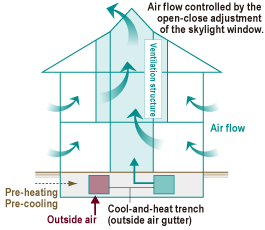In Academic Year 2009, having entered its 5th year of incorporation, the university sought to revitalize education and research, promote collaboration with the local community in research activities, and optimize university administration by revising the structure of faculties and departments based on our midterm plan. As a result, we saw a 25% increase over the previous year in research revenues for university-industry collaborations, etc. On the other hand, overall revenues fell from the previous year due to a reduction in subsidy revenues for operational expenses, etc. We are moving forward with our efforts to obtain external research funding, etc. and increase the efficiency of our operations.
Financial Status of Iwate Prefectural University(As of March 31, 2010)
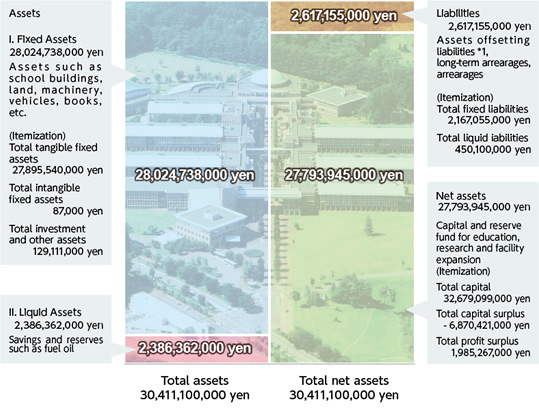
*1 Assets offsetting liabilities is a special measure for public university corporations, used so that depreciation does not affect the calculation of profits and losses: when fixed assets are acquired, an amount equivalent to these assets will be calculated as liabilities, and whenever expenses are incurred from depreciation, the amount will be reversed to income.
The total education and research expenses for Iwate Prefectural University were 4,465,910,000 yen for the 2009 academic year. The educational expenses per student were approximately 970,000 yen, including education expenses, education and research support expenses, and part of the faculty personnel expenses. The research expenses per faculty member were approximately 2.9 million yen.
Education and research expenses

Education expenses per student
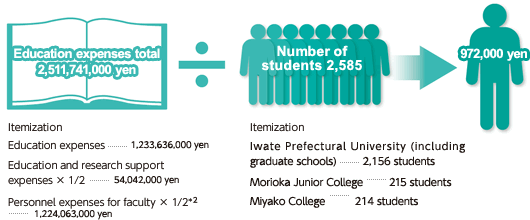
*2 Since faculty members conduct both educational and research activities, the personnel expenses relevant to education were calculated as 1/2.
Research expenses per faculty member

Operational subsidies from Iwate Prefecture account for approximately 70% of the revenue.
IPU’s self-generated funds, including tuition, matriculation and examination fees, and research income from industry-university collaboration, etc. account for 26.7% of the revenue.
| Item | Amount (in thousand yen) |
Percentage | Notes |
|---|---|---|---|
| Operational subsidies | 4,246,990 | 70.2 | Operational subsidies from the prefecture |
| Tuition | 1,204,826 | 19.9 | University’s self-generated funds (independent sources of revenue) |
| Matriculation and examination fees |
241,875 | 4.0 | |
| Research income from industry-university collaboration, etc. |
57,223 | 0.9 | Revenue from research and projects commissioned by outside companies and organizations |
| Grants | 16,934 | 0.3 | University reformation promotion subsidy, donations, etc. |
| Donations | 11,813 | 0.2 | |
| Assets offsetting liabilities reimbursement* |
158,973 | 2.6 | |
| Miscellaneous | 115,064 | 1.9 | |
| Total(A) | 6,053,698 |
*Assets offsetting liabilities reimbursement is the monetization of the equivalent value of the asset depreciation amount from assets offsetting liabilities.
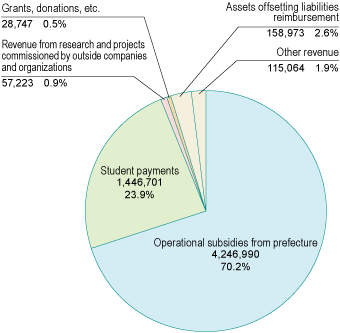
Education and research expenses account for approximately 37% of the expenditures. In Academic Year 2009, we saw an increase over the previous year in both the amount and percentage of research income from university-industry collaborations, etc. (year over year increase of 25.4%)
| Item | Amount (in thousand yen) |
Percentage | Notes |
|---|---|---|---|
| Education expenses | 1,233,636 | 22.5 | Expenses for education and research |
| Research expenses | 676,063 | 12.3 | |
| Education and research support expenses |
108,084 | 2.0 | |
| Research expenses for university-industry collaborations, etc. |
58,322 | 1.1 | Expenses for research and projects commissioned by outside companies and organizations |
| Personnel expenses for trustees |
10,873 | 0.2 | Personnel expenses for trustees, faculty, part-time lecturers and administrative staff |
| Personnel expenses for faculty |
2,448,127 | 44.7 | |
| Personnel expenses for administrative staff |
573,739 | 10.5 | |
| General administrative expenses |
367,966 | 6.7 | Expenses for utilities, repairs, consumables, etc. |
| Total(B) | 5,476,810 |
|
In Academic Year 2009, by postponing some of the equipment renewals to the following year through a process of reviewing expenses for the university information systems, and by making salary revisions recommended by the prefectural personnel commission, gross income increased by more than 340 million yen compared to the previous year. As for the gross income for this period, there is a plan to save it in the reserves for specific purposes.
About 70% of the operating costs of Iwate Prefectural University are covered by the operational subsidies from the prefecture. However, this subsidy decreases by 1.5% from the previous year based on the prefecture’s rule for calculating subsidies. For this reason, the overall income is on a downward trend.
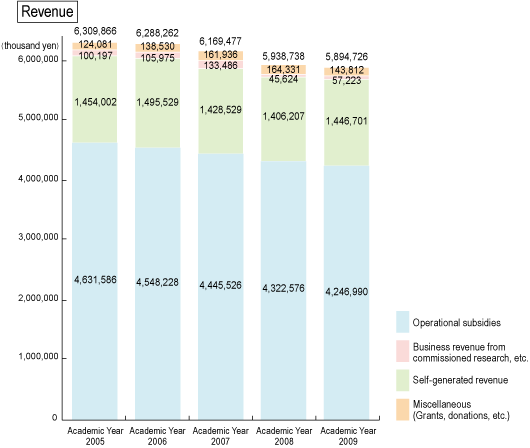
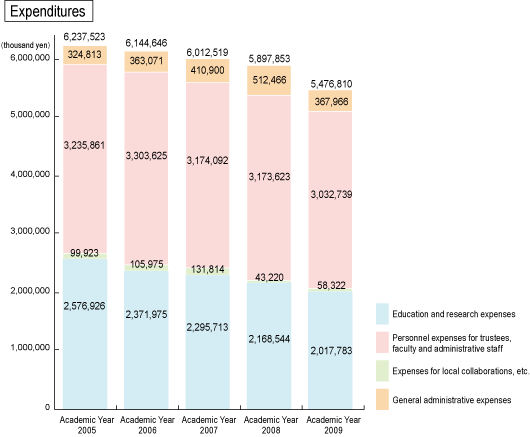
|
||
|



